Kentucky is not a very large state, but it has a lot going for it, with lots of parks, lots of beautiful waterways, and a rich Appalachian culture that has made huge contributions to American culture as a whole. Not surprisingly, there are also some interesting mushrooms—here are a few of them[i].
Start reading about mushrooms, and you’ll soon notice two very different messages about foraging. One is that foraging for edible wild mushrooms is both easy and fun, and by the way here are three or five or ten fool-proof species to get you started! The other message is that a lot mushrooms are poisonous, and unless you get someone with a PhD is entomology to come help you, you’ll likely poison yourself and die.
The truth is that while there is a bit of a learning curve with mushrooms, you can indeed learn how to forage safely, no PhD required—but it’s important to respect the steepness of that curve. Learning to recognize a single edible mushroom and then collecting and eating it isn’t good enough. What if a toxic look-alike that you didn’t know about is introduced to your area, will you be able to tell the difference? It all requires some study.
This article is to motivate you to study.
If you do indeed go Mushroom Hunting make sure you have the proper tools, take a quality knife with you and a basket/bag for your haul!
This article is just some encouragement to help get you up that learning curve. This list is not meant to be used as a replacement for a field guide, spore prints, an identification app or an in person guide.
Our Recommended Field Guides in Kentucky
COVER | TITLE | Header | ||
|---|---|---|---|---|
OUR #1 RATED | ||||
Edible Mushrooms in Kentucky
Puffballs
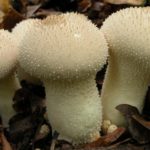

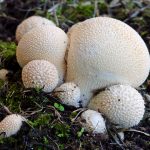



Puffballs are a group of mostly-unrelated fungi that all have one thing in common: ball-shaped fruiting bodies. Some have stems, others do not. Many are edible—some people say that all puffballs are edible, but that’s only because they define the poisonous puffs as not real puffballs somehow. Even with puffballs, identifying mushrooms to species is critical.
More difficult than differentiating poisonous puffs from the edible ones is telling the difference between puffs and the egg-stage of certain other mushrooms, some of which are dangerously poisonous—the key is to slice the mushroom vertically, because a real puffball is always homogeneous inside. Mushroom-eggs aren’t. The inside also has to be white. Discoloration is a sign that the puff is starting to mature and is no longer edible.
Kentucky has at least three edible species, the Common and Pear-shaped puffballs (Lycoperdon perlatum and Lycoperdon pyriforme), and the aptly-named Giant Puffball (Calvatia gigantea).
Chicken-of-the-woods (Laetiporus sp.)


Chicken of the Woods is any of several very similar species, most of which are yellow or yellow and orange (a few are pink or are partially white) and do, indeed, taste like chicken. The taxonomy of the group is not yet entirely worked out, which is unfortunate as some chickens can make sensitive people a little ill, while others are safer. It’s hard to be sure which species Kentucky has, but it seems to have at least two.
Hen-of-the-woods (Grifola frondosa)
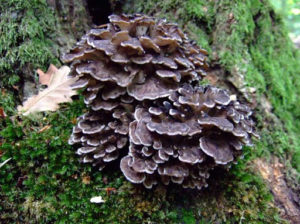

Hen-of-the-woods has a name easily confused with that of chicken-of-the-woods, but fortunately the two don’t look very much alike. Hen is named for its appearance, not its taste, for it resembles a pile of gray chicken feathers. It’s especially good cooked with cheese. You’ve heard of cheese-steaks? This would be a cheese-mushroom.
Black-staining Polypore (Meripilus Sumstinei)


Meripilus Sumstinei looks somewhat similar to hen-of-the-woods, but its flavor is much more distinctive and intense. Unfortunately, it’s also a challenge to cook, because this mushroom is very chewy—all but the edge may actually be woody.
Lion’s Mane (Hericium erinaceus)
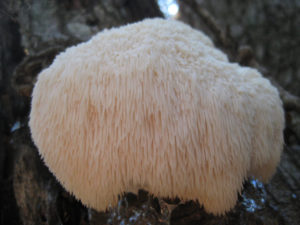

Lion’s mane mushroom tastes like crab and looks like a white or whitish tribble (a creature from from Star Trek; picture a potato thickly covered with very fine noodles). Surprisingly, the hairlike spines do not give the mushroom an odd texture in the mouth.
Lion’s mane has no poisonous look-alikes, but it does have several close relatives that share its noodly strangeness and taste very similar. Among the group, lion’s mane is distinctive in that its club-shaped body does not branch.
Oyster Mushrooms (Pleurotus sp.)
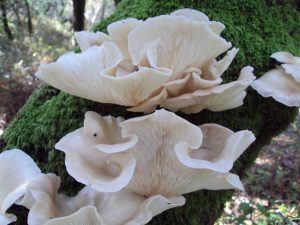

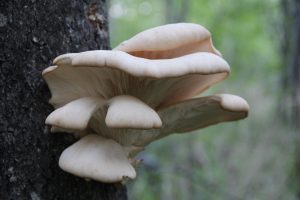

Oyster mushrooms are closely-related, and many look similar to each other—most (not all) are soft and fan-shaped, attached to the tree they grow from either directly on the side or by a short stem set on the side like the handle of a frying pan. Taste and texture vary, but “delicate” is a good word for the group. They are popular for home cultivation. Kentucky has at least two species growing wild, the Summer Oyster (P. pulmonarius) and the Aspen Oyster (P. populinus), which look, unfortunately, almost identical to each other.
Edible Amanitas
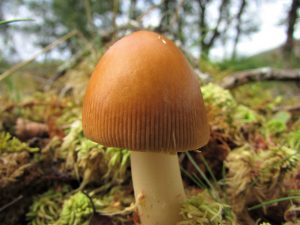



The idea of an edible Amanita may sound like a sick joke to those who know a little bit about mushrooms, because the first thing many budding mushroom enthusiasts learn is “don’t go near Amanitas, they’ll kill you!” But actually, there are members of the genus that are safe to eat. Others may cause serious illness if eaten raw, but can be safely eaten if they are processed properly. Some of these are hallucinogenic, and can be used for ether recreational and spiritual purposes, if processed properly, but are more dangerous than the more popular psilocybin mushrooms. The reason foragers are warned away from Amanitas categorically is that many of these mushrooms look alike, especially to an inexperienced eye, and a mistake could easily kill.
Kentucky’s edible Amanitas include the Tawny Grisette (Amanita fulva) and the American Slender Caesar’s Mushroom (Amanita jacksonii). The admonition to leave all Amanitas alone may be sound, however.
American Cauliflower Mushroom (Sparassis americana)
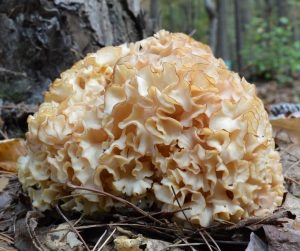

This one looks like a large pile of noodles on the ground, though it has also been compared to a brain or to noodles. It can grow very large and is considered choice.
Snow fungus (Tremella fuciformis)


Snow fungus is a little almost-translucent blobby not much appreciated in the United States but popular in China. It tastes like something very close to nothing but has an interesting texture and is also prized for its health benefits.
Indigo Milkcap (Lactarius indigo)
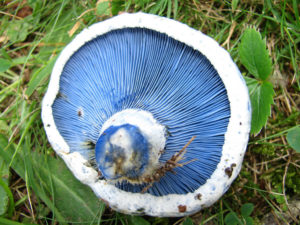

Indigo milk caps are unusual in being both safe to eat and entirely blue. Unfortunately, the cooking methods that best bring out their rich flavor also make the color fade, while cooking methods that protect the color tend to slightly degrade the taste—they’ll be good, not great. So you get to choose, great color or great flavor. Of course, if you choose flavor, you won’t be able to see the color of the mushroom inside you anyway.
Our Recommended Field Guides in Kentucky
COVER | TITLE | Header | ||
|---|---|---|---|---|
OUR #1 RATED | ||||
Poisonous Mushrooms in Kentucky
The following list is not by any means exhaustive! There are other poisonous mushrooms in the state, some of them quite dangerous. Then there are the species that are only poisonous sometimes, whether do to improper cooking, advanced age, some sensitivity on the part of the eater, or some other variable that nobody understands, yet. Don’t assume that a mushroom not on this list is safe—rather, the point of this discussion is to get you started thinking about what actual poisonous mushrooms are like.
By the way, the ONLY way to tell if a mushroom is poisonous is by figuring out what its species is and then looking it up. Looking for signs of feeding animals won’t help, as there are animals who can safely eat mushrooms that are poisonous to humans. Memorizing rules, like never eat a mushroom with this characteristic, only eat mushrooms with that characteristic, is utterly pointless. All such rules have exceptions, and the exceptions can kill you.
Learn to identify mushrooms, then look them up. It’s not easy, but it is simple.
Red Brittlegills (Russula sp.)
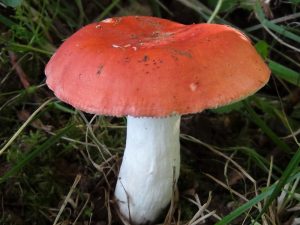

Not all brittlegills are red, but at least some of the red ones are poisonous—they won’t kill you, but they can make you seriously regret eating them. Curiously, red brittlegills are also almost impossible to identify to species, in large part because current species definitions are based on such characteristics as the exact shade of red of the cap or the exact degree of difficulty in peeling away the top layer of the cap. Most probably, the whole thing will be reorganized soon based on genetic evidence. In the mean-time, just know that while eating a red Russula will likely make you vomit, attempting to figure out which Russula you ate will likely drive you to drink.
Jack O’Lantern (Omphalotus illudens)
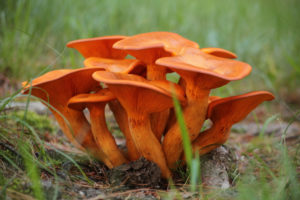

The jack o’lantern mushroom is well-known as a poisonous—and glow-in-the-dark—look-alike of the golden chanterelle. However, its resemblance to a chanterelle is vague, and there are people who have spend a lot of time in the dark with these things without ever seeing them glow. But even vague similarity is enough to cause a mistake, and it really is true that these things are poisonous.
By the way, it’s not uncommon for writers to use the wrong scientific name for this species. That’s because the name, jack o’lantern, refers to several very similar and closely-related mushrooms, and writers sometimes use the name of the wrong jack by mistake.
Earthballs (Scleroderma sp.)
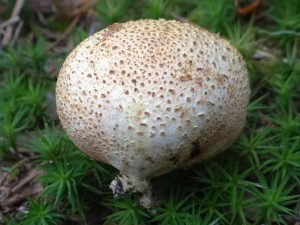

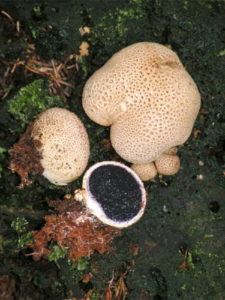

Earthballs are poisonous puffballs. They are not deadly, but can cause serious illness. They differ from edible puffballs most obviously in being more firm—like a rubber ball, rather than a marshmallow. They also have a thicker, tougher skin, and their interior starts darkening very early in development, eventually turning black.
Kentucky has at least two species, the Leopard Earthball (Scleroderma areolatum) and The Common Earthball (Scleroderma citrinum).
Poisonous Amanitas


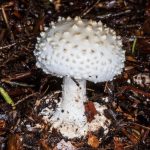

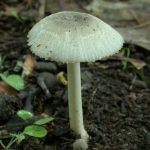

Some Amanitas are among the most dangerous mushrooms on Earth, containing lethal doses of a curious toxin that takes a long time to show symptoms and can show a temporary false recovery before shutting down the liver and kidneys. Those who get prompt and appropriate medical attention sometimes recover, and a few of these even manage to avoid organ failure, but even with medical help, survival is not assured. Among these are the destroying angels, several species of large, handsome, white or whitish mushrooms that can be mistaken for several choice edibles (hint: pay attention to detail!). Kentucky’s Destroying Angel is A. bisporigera.
Amanita abrupta and Amanita farinosa both also live in the state and are toxic and potentially deadly.
Our Recommended Field Guides in Kentucky
COVER | TITLE | Header | ||
|---|---|---|---|---|
OUR #1 RATED | ||||
Magic Mushrooms in Kentucky
The “magic” of most magic mushrooms is due to the action of a substance called psilocybin, which is illegal to use or possess in any form in most jurisdictions. People who choose to risk legal trouble also face further risk in the shape of toxic look-alikes, since psilocybin mushrooms are small, nondescript, and brownish, as are a great many other species, some of which are dangerously poisonous. Harvest the wrong one, and you die. Psilocybin itself is not risk-free to ingest, but as mind-altering substances go, it’s relatively safe. And the mushrooms themselves are interesting.
Here are the Psilocybin mushrooms of Kentucky[ii].
Panaeolus
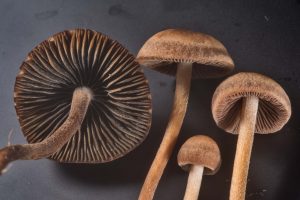

Members of this genus, often called mottlegills, or simply “pans,” are distinctive in that their spores mature and darken in patches, giving the gills a mottled appearance. Only some mottlegill species are psychoactive, but some of those that are active are extremely so. Kentucky’s one species, The Banded Mottlegill (Panaeolus cinctulus), is psychoactive but not very strongly so.
Psilocybe
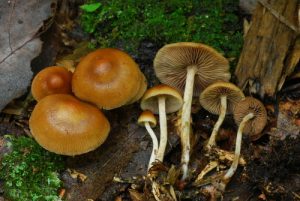

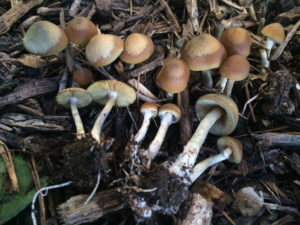

This is the genus of the famous and very widely cultivated Psilocybe cubensis, but “cubes” don’t grow wild in Kentucky—Little Bluefoot (Psilocybe caerulipes) and Big Bluefoot (Psilocybe ovoideocystidiata) do. Both seem to have a typical potency close to that of their more famous cousin, but they vary significantly, with some individual mushrooms being much weaker and others much stronger.
References:
[i] (n.d.). Observations. iNaturalist
[ii] (n.d.). Which Psilocybin Mushrooms Grow Wild in My Area? Shroomery
Our Recommended Field Guides in Kentucky
COVER | TITLE | Header | ||
|---|---|---|---|---|
OUR #1 RATED | ||||


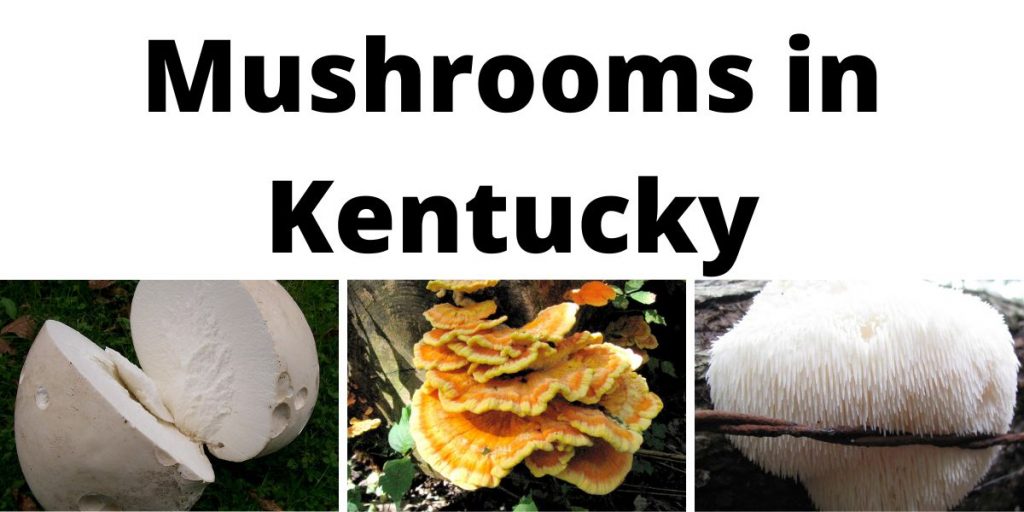
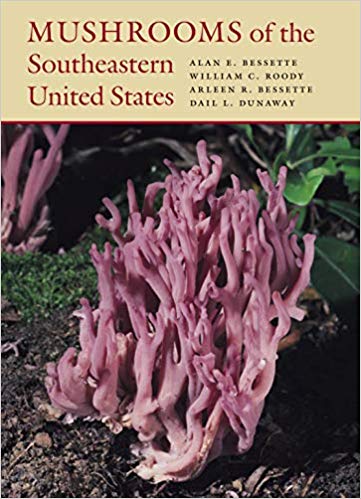
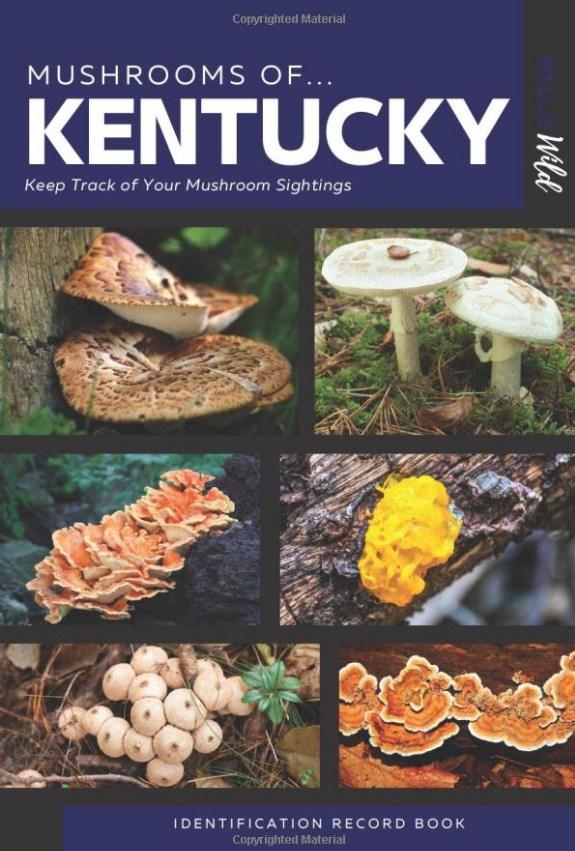


Thanks for the info, Recently moved here from Florida and I’m loving the terrain and looking forward to shrooming Before the cold weather hits, your information was very wonderful and to the point thank you again